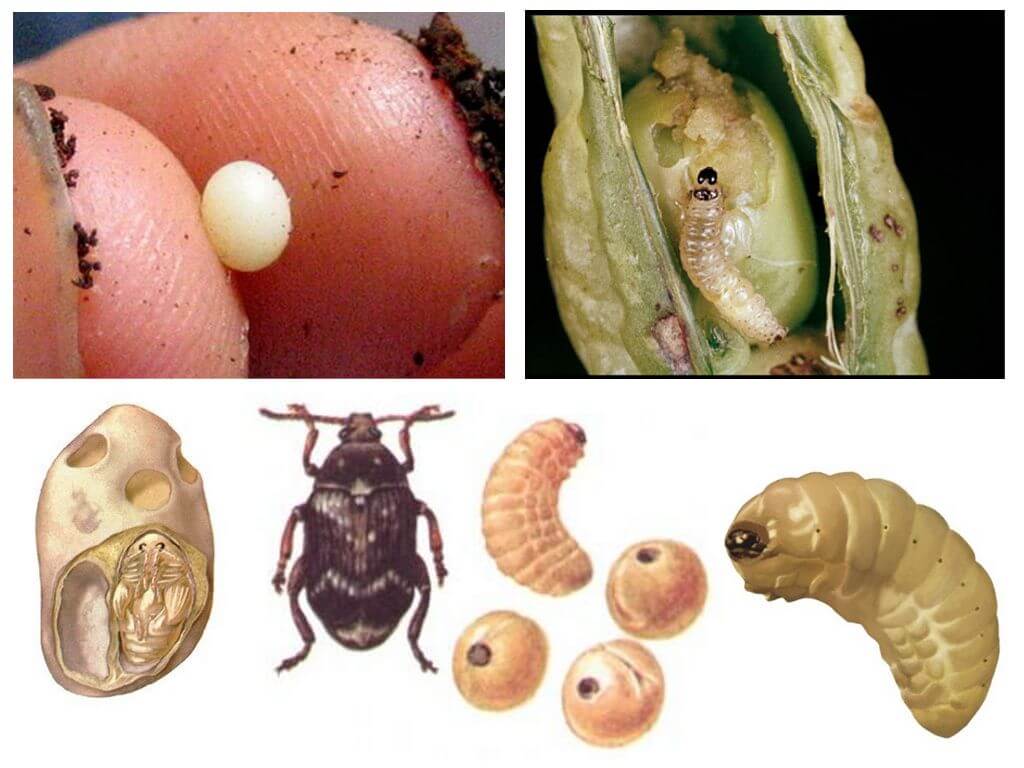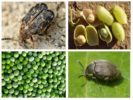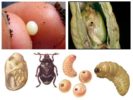- Pea seed
- Pea Eggs and Larvae
Features of the structure and appearance of pea weevil
A small black bug with an elongated head, belonging to the family of seeds of the winged wing order, reaches a length of 4-5 millimeters. His body has a wide oval specific shape. On top of the insect is covered with a reddish-gray thick drooping. Small shortened elytra with an oblique light stripe do not cover the entire abdomen, at the end of which there is a white cross-shaped pattern. Pea weevils differ from brothers in the presence of this mark. The tibiae, legs of the middle legs and three segments of the antennae are painted in a reddish-red hue. The pest has bulging eyes, and large pointed teeth are clearly visible on the hips of the hind legs.
It is rather difficult for non-specialists to determine the sex of pea pests. Insects differ in the structure of the genital organs and the length of the antennae, which are slightly larger in males. Pea weevil in the photo presented on our website will allow you to carefully consider and familiarize yourself with the features of the insect.

Insect development
A beetle that destroys peas is widespread in the European and Asian parts of the Russian Federation, where crops are sown massively. The boundaries of the insect's habitat are inconsistent, they vary depending on favorable weather conditions. There are many places where pea weevils winters. These are mainly storages in which peas are stored. In the southern regions, a significant part of the grains is waiting for the cold season and settles for wintering in the stacks of straw, under the bark of trees, among the remains of plants or in the soil.
Bulk beetles emerge from peas at a temperature of 26-28 ° C. At lower temperatures, this process slows down. High humidity favorably affects the appearance of pests from infected grains. Mostly overwintered parasites appear in May and are fond of flowering gardens, clusters of weeds and thickets of bird cherry trees along the edges of forest belts. Pea grains come to the fields along with the seeds, but most of them come from the surrounding places. The largest number of beetles appears in the fields in May, during the mass flowering of plants. Cereals eat flower petals and pollen during this period.
Important! Fields of parasites begin to populate from the edges, gradually occupying the entire plantation. In the mornings and evenings, adults hide in pea flowers or between closed young leaves.
Female pea weevils begin to lay eggs en masse in early June. They place a masonry, consisting of an average of 35 eggs, on top of the green pea beans, firmly gluing it on the shoots of plants using a special liquid mass. After drying, it forms a protective shell, under which are placed a half-millimeter amber-yellow oblong eggs. Their development lasts depending on conditions for 6-12 days. The female can lay from 70 to 200 eggs for the entire period of her life, which lasts one year.
Having been born, the grain of the grain gnaws through the fleshy shell of the bean and enters its middle. Here she gets to still green pea grains, in which the whole process of pest development from the larva, pupa and adult beetle takes place.
Interesting! Several individuals can enter a pea, but only one survives and develops.

The inlet in the grain shell overgrows with time and a small black dot remains. Before molting, the larvae have a worm-shaped body of a reddish color, covered with long hairs. A newborn individual has a pair of legs. After a few days, it sheds and becomes legless, with its head strongly drawn into the front of the chest. Her color becomes cream. Eating nutritious food, it gradually reaches a length of 5-6 mm. Molting several times, the larva completes its development. Before pupation, it forms a stroke up to the pea peel, but does not gnaw through it. In the resulting cavity will be a young bug. It is enough for him under favorable conditions to put pressure on the lid to go outside. The emergence of adult caryopsis occurs in late July.
Damage and the fight against pea weevil
The parasite is common in all countries of Asia, Europe and North America, where peas are intensively grown. The closest relatives of the pest is the Egyptian pea weevil, bean kernels and other pests of legumes. All of them cause enormous damage to crops. Adult pea weevils hit the harvest in storage, and their larvae in the fields.
Important! Spoiled seeds lose almost 40% in weight. Their germination capacity is reduced to 75% and quality.
Avoid eating and feeding cattle with contaminated peas. It is dangerous because beetles, larvae or their excrement, which cause inflammation of the intestines and kidneys, can be found in damaged grains.
In order to preserve the grain stock from parasites, it is necessary to apply all known measures to combat pea weevil:
- Grain treatment with insecticides;
- Grain cooling;
- Preventive treatment and maintenance of cleanliness in warehouses.





